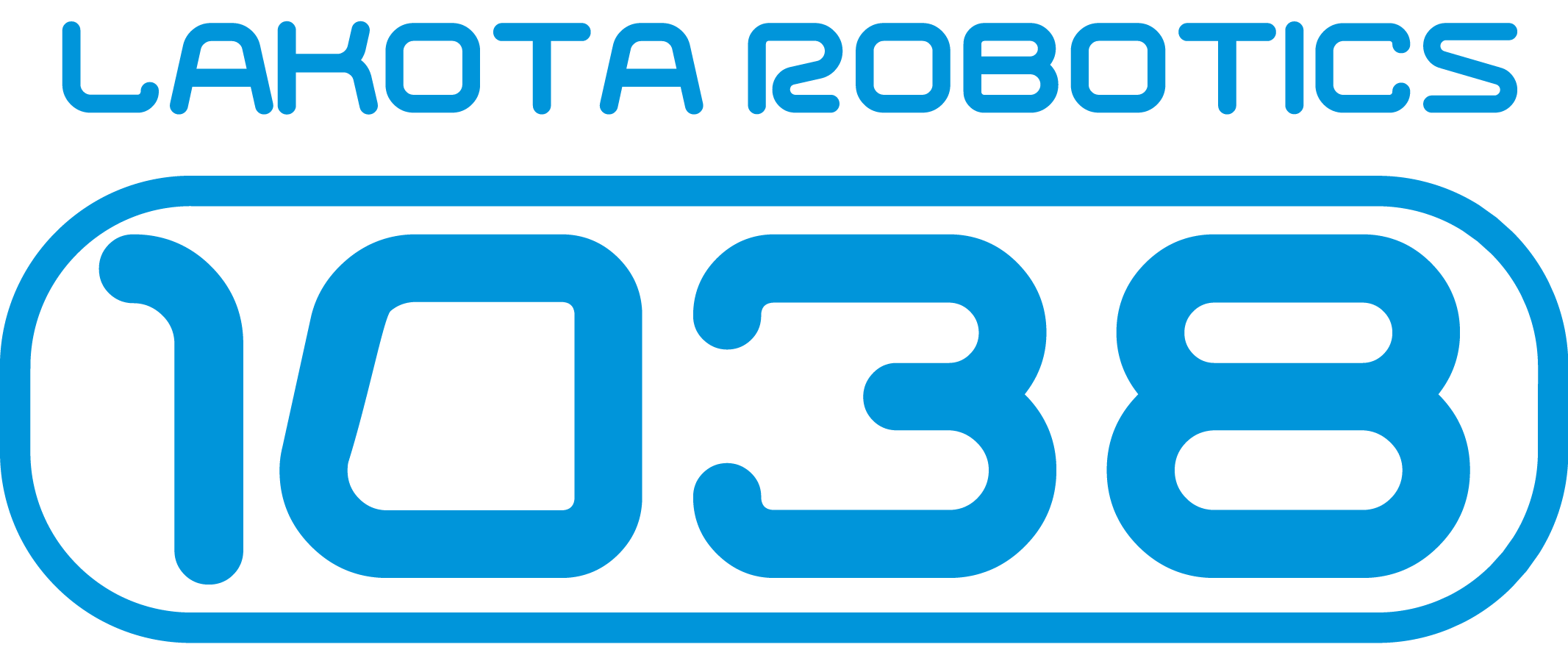
2019 Game: Destination Deep Space
Lakota Robotics | Game Announcements
2019 Game: Destination Deep Space
Check out this game reveal video!
Robot Name: Oggsmonaut
In honor of: Anthony and Adam Ogg

Field
Destination: Deep Space is played on a 27 ft (823 cm) by 54 ft (1646 cm) field that is covered in grey carpet. The field is bounded by transparent polycarbonate guardrails on the longer sides and the Alliance Station walls on the shorter side. The field features two types of zones, one for each alliance. The habitat zone contains robots at the start and end of each match, while the alliance station is where drivers control their robots. For the first time, a Google Cardboard headset was included in the kickoff kit to allow teams to view a virtual field.
Alliance Station
Each alliance has their own Alliance Station that is positioned at one of the ends of the field. The Alliance Station is where drivers control their robots, human players deliver game pieces to robots, and coaches give advice to their team members. Each alliance station features two game piece holding areas on the sides of the driver stations.
Depots
Depots are placed on the field next to the alliance stations, with two per alliance. Before the match starts, alliances are permitted to stage cargo in their respective depots for robots to retrieve during the match.
Sandstorm
The sandstorm is installed above each alliance’s alliance station, and is used to obscure the drive team’s vision during the sandstorm period. Once that period ends, the sandstorm retracts in order to allow drivers to see the field for the remainder of the match.
Loading Stations
Each alliance station features two loading stations near the edges of the alliance station. Human players use the loading stations to deliver hatch covers and cargo to robots through a chute, where they can be collected by a waiting robot.
Scoring Areas
Rockets
There are four rockets on the field, two per alliance. Each rocket features three levels, made up of two bays, where game pieces can be scored. Two hatch covers and two pieces of cargo can be scored on each level.
Cargo Ships
There are two cargo ships placed in the middle of the field, one per alliance. As with the rockets, each cargo ship features bays where hatch covers and cargo can be scored. Each cargo ship has eight bays, each capable of holding one hatch cover and one cargo.
Habitat Platforms
Each alliance controls one habitat platform near the alliance station wall. Robots start the match at their alliance’s respective habitat platform, and must return to the same platform at the end of the match. Each habitat platform has three levels, and parking on a higher level at the end of the match earns the alliance more points.
Gameplay and Scoring
Scoring Elements
There are two scoring elements in Destination: Deep Space; hatch covers and cargo. Hatch covers are 19 in. (~48 cm) diameter polycarbonate toroids, and cargo is represented by orange 13 in. (~33 cm) playground balls.
Sandstorm Period
For the 2019 season, the sandstorm period replaced the autonomous period, which had been used in many previous FRC games. Robots start the match at their respective habitat platforms, fully supported by habitat platform level one or two. The first 15 seconds of the match is the sandstorm period, where robots act solely on pre-programmed instructions, therefore acting autonomously, or under control of their drivers with the aid of a vision system mounted on the robot. Robots can earn points in a variety of ways. For each robot that fully crosses the habitat line during the sandstorm period, the alliance earns three points if the robot started on habitat platform level one and six points if the robot started on level two. Robots are also able to earn points for scoring hatch panels and cargo on their alliance’s rockets and cargo ship. As these actions carry the same point value as if they occurred in the teleop period, they will be further discussed in that section.
Teleop Period
After the sandstorm period ends, the teleop (tele-operated) period begins, which lasts for 135 seconds. Drivers control their robot from their Driver Station and human players continue to deliver game pieces to the robots. During this period, as in autonomous, every hatch panel scored on a rocket or cargo ship will earn three points for the alliance. Additionally, scoring cargo into a rocket or cargo ship will earn three points for the alliance.
End Game
The last 30 seconds of the teleop period is called the end game. During this time, robots can earn additional points by climbing back onto their alliance’s habitat platform. A robot ending the match on level one will earn the alliance 3 points, while ending the match on level two will earn 6 points and ending the match on level three will earn 12 points.
Special Scoring
In addition to earning match points, an alliance can earn a ranking point during the qualification rounds by accumulating a total of 15 end game points at the end of the match, which is known as habitat docking. An alliance can also earn a ranking point by completing a rocket, which entails scoring two hatch covers and two pieces of cargo on each level. A foul will result in 3 points being credited to the opposing alliance, and a tech foul will result in 10 points being credited to the opposing alliance.
Scoring Summary
| Action | Sandstorm | Teleop | Ranking Points |
|---|---|---|---|
| Sandstorm Bonus (Level One) | 3 points | ||
| Sandstorm Bonus (Level Two) | 6 points | ||
| Hatch Panel | 2 points | 2 points | |
| Cargo | 3 points | 3 points | |
| Habitat Climb Bonus (Level One) | 3 points | ||
| Habitat Climb Bonus (Level Two) | 6 points | ||
| Habitat Climb Bonus (Level Three) | 12 points | ||
| Habitat Docking | 1 RP (in Qualification) | ||
| One Complete Rocket | 1 RP (in Qualification) | ||
| Foul | 3 points | 3 points | |
| Tech Foul | 10 points | 10 points | |
| Win | 2 RP (in Qualification) | ||
| Tie | 1 RP (in Qualification) |
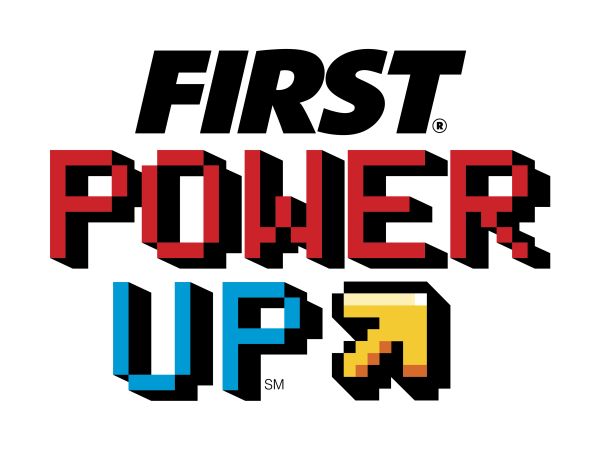
2018 Game: FIRST Power Up
Lakota Robotics | Game Announcements
2018 Game: FIRST Power Up
Check out this game reveal video!
Robot Name: Power Up Paul George (P-UPG)
In honor of: Paul George

Field
FIRST Power Up is played on a 27 ft (823 cm) by 54 ft (1646 cm) field that is covered in grey carpet, called the “Arcade”. The field is bounded by transparent polycarbonate guardrails on the longer sides and the Alliance Station walls on the shorter side. While most of the field is alliance-neutral, including where the scoring areas are located, there are some alliance-specific zones, which are the Null Territory, Platform Zone, Power Cube Zone and Exchange Zone on the field, and the Alliance Station and Portals outside the field. All zones belong to the alliance whose Alliance Station is closest to the zone, with the exception of Null Territory and the Portals.
Power Cube Zone
The Power Cube Zone is an alliance-specific area in front of the Switch that contains 10 power cubes for the alliance that owns the Power Cube Zone to use. Robots of the opposing alliance may not cause Power Cubes that are inside the Power Cube Zone to be removed from the Power Cube Zone. The Power Cube Zone includes the tape used to define the area, but not the Switch that it is adjacent to. The Auto Line runs parallel to the Alliance Station wall, crossing through the centre of the Power Cube Zone, and touching both Guardrails.
Platform Zone
The Platform Zone is an alliance-specific area between the Switch and Scale that protects robots from opposition interference and gives additional freedoms when attempting end game objectives such as climbing. It includes the tape, Switch and Tower walls used to define the area as well as the rung connected to the Tower. It also contains 6 power cubes that are available for both alliances to use.
Null Territory
Null Territory is an alliance-specific area next to the alliance’s Plate on the Scale that protects robots from opposition interference when attempting to place power cubes on the scale. It includes the tape used to define the area but not the Guardrails.
Exchange Zone
The Exchange Zone is an alliance-specific area next to the Alliance Station wall that stops opposing robots blocking access to where the alliance’s robots can give power cubes to their Human Players through the Exchange. It includes the tape used to define the area but not the Alliance Station wall.
Portals
Each alliance owns two Portals at the two corners opposite to its Alliance Station. This is where Human Players can give robots additional power cubes through the walls and each contains 7 power cubes. It includes the tape and the wall used to define the area.
Alliance Station
Each alliance owns an Alliance Station that is at one of the ends of the field. The Alliance Station is where Drivers control their robots at the Driver Stations, Human Players manage power cubes and Coaches give advice to their team members. Technicians must stay outside of the Alliance Station and the Portals at all times. At the beginning of the match, during the Autonomous Period, all alliance members must stay behind the Starting Line in the Alliance Stations.
Exchange
The Exchange is a place in the Alliance Station wall where robots can give power cubes to their Alliance Station for either storage in the Alliance Station, storage in the Vault or return to the field. The Exchange Zone surrounds the Exchange, making it a protected area.
Vault
The Vault is a device at the back of the Alliance Station that Human Players interact with to obtain power ups. Human Players place power cubes, which are collected from the field through the Exchange, inside the Vault to earn Power Ups, with the strength of each Power Up related to how many power cubes are inside the Vault when the power up is played.
Scoring Areas
There are two Switches, one owned by each alliance, and a Scale, which is neutral, located on the field. An alliance’s Switch is located 14ft (427cm) in front of the Alliance Station wall and its Plates are 9in (23cm) above the carpet when level. The Scale is located in the centre of the field and its plates are 5ft (152cm) above the carpet when the match begins. The two rungs connected to the Scale’s Tower are 7ft (213cm) above the carpet, extend 8.25in (21cm) out from the Tower and are 1ft 1in (33cm) across. There are two Plates on each end of the Scales and Switches, one belonging to each alliance. At the beginning of the match, the Plates that each alliance owns are randomised.
Ownership
Switches and Scales begin the match level, with no alliance having ownership. An alliance gains ownership of a Switch or Scale if, by placing power cubes on their Plate, the respective Switch or Scale is tipped by the weight of the power cubes. An alliance also gains ownership of their Switch if the Force Power Up is played at level 1 or 3, and gains ownership of the Scale if the Force Power Up is played at level 2 or 3.
Gameplay and Scoring
Scoring Elements
There is only one scoring element in this game, power cubes. Power cubes are 1ft 1in (33cm) wide, 1ft 1in deep and 11in (27cm) tall milk crates covered in a yellow nylon cover. The FIRST logo covers the open face of the milk crate.
Autonomous Period
Robots start the match contacting their Alliance Station wall, with no part of the robot inside the Exchange Zone, with up to 1 power cube preloaded onto the robot. The first 15 seconds of the match is the Autonomous Period, where robots act solely on pre-programmed instructions, hence acting autonomously. Drivers and Human Players must stay behind the Starting Line throughout this period. Robots can earn points in a variety of ways. If any part of a robot’s bumpers completely cross the Auto Line, they gain 5 points for their alliance. However, they may not pass Null Territory to stop opposing robots completing their Autonomous tasks. If an alliance gains ownership of the Scale or their own Switch, they gain 2 points. For every whole second that an alliance owns the Scale or their Switch in Autonomous, they gain an additional 2 points.
Teleop Period
After the Autonomous Period ends, the Teleop (Tele-operated) Period begins, which lasts for 135 seconds. Drivers control their robot from their Driver Station and Human Players deliver power cubes through the Portals and place power cubes in the Vault. If an alliance gains ownership of their Switch in Teleop, they gain 1 point, or 2 points if the Boost Power Up is active at level 1 or 3. For every whole second that an alliance owns their Switch in Teleop, they gain an additional 1 point, or 2 points if the Boost Power Up is active at level 1 or 3. If an alliance gains ownership of the Scale in Teleop, they gain 1 point, or 2 points if the Boost Power Up is active at level 2 or 3. For every whole second that an alliance owns the Scale in Teleop, they gain an additional 1 point, or 2 points if the Boost Power Up is active at level 2 or 3. For every power cube an alliance places in their Vault, they gain 5 points.
Power Ups
During the Teleop Period, teams have access to three Power Ups: Levitate, Force, and Boost. These Power Ups are activated through placing power cubes that are obtained through the Exchange in the Vault. No two Power Ups can be active simultaneously with the exception of Levitate, which both alliances can activate at any point during the Teleop Period. After a Power Up has been activated by an alliance, it cannot be used again. Except for Levitate, all Power Ups last for 10 seconds, and if another Power Up is activated in this time (except for Levitate) it is placed in a queue. The number of power cubes required and effects of the Power Ups are detailed in the table below.
| Power Up | Power Cubes Required (Level) | Effect |
|---|---|---|
| Levitate | 3 | Alliance earns a free Climb (only if 2 or less robots have earned a Climb) |
| Force | 1 | Alliance gains Ownership of their Switch |
| 2 | Alliance gains Ownership of the Scale | |
| 3 | Alliance gains Ownership of both their Switch and the Scale | |
| Boost | 1 | Alliance gains double Ownership points from their Switch |
| 2 | Alliance gains double Ownership points from the Scale | |
| 3 | Alliance gains double Ownership points from both their Switch and the Scale |
End Game
The last 30 seconds of the Teleop Period is called the End Game. During this time, robots can earn additional points by performing tasks in their Platform Zone. If a robot is fully supported by the Scale, fully outside the opponent’s Platform Zone and has its bumpers at least when time runs out, the robot earns a Climb and 30 points. If a robot has met all of the criteria above but does not have its bumpers at least when time runs out, the robot earns a Park and 5 points. If the Levitate Power Up has been activated and no more than 2 robots have Climbed, a Climb is credited to a random robot who has not Parked or Climbed. If all robots have at least Parked, one random robot who has not Climbed will be credited with a Climb.
Special Scoring
In addition to these methods of scoring, alliances can perform special tasks to gain additional points. If an alliance can get all 3 of their robots to complete an Auto-Run and have ownership of their Switch at the end of the Autonomous Period, they have completed the Auto Quest and gain 1 extra Ranking Point in qualification matches. If an alliance has all 3 of their robots credited with a Climb (whether through an actual Climb or the Levitate Power Up), they can Face the Boss and gain 1 extra Ranking Point in qualification matches. If an alliance breaks a rule, they may be penalized. A Foul will result 5 points being credited to the opposing alliance, and a Tech Foul will result in 25 points being credited to the opposing alliance.
Scoring Summary
| Action | Autonomous | Teleop | Ranking Points |
|---|---|---|---|
| Auto-Run | 5 points | ||
| Ownership of Scale | 2 points + 2 points/second | 1 point + 1 point/second2 points + 2 points/second if Boost level 2 or 3 active | |
| Ownership of Alliance’s Switch | 2 points + 2 points/second | 1 point + 1 point/second2 points + 2 points/second if Boost level 1 or 3 active | |
| Vault | 5 points | ||
| Parking | 5 points | ||
| Climbing | 30 points | ||
| Face the Boss | 1 RP(in Qualification) | ||
| Auto Quest | 1 RP(in Qualification) | ||
| Foul | 5 points | 5 points | |
| Tech Foul | 25 points | 25 points | |
| Win | 2 RP(in Qualification) | ||
| Tie | 1 RP(in Qualification) |
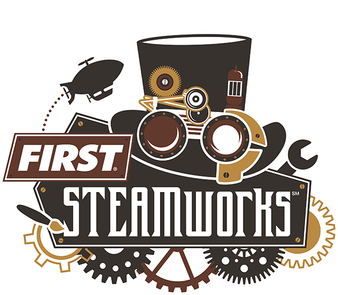
2017 Game: FIRST Steamworks
Lakota Robotics | Game Announcements
2017 Game: FIRST Steamworks
Robot Name: Double Trouble Dan

In Loving Memory of Dan Deganis (March 13, 1963 – February 8, 2017)

Field
FIRST Steamworks is played on a field 27ft (823cm) by 54ft 4in (1656cm), covered in green carpet and bounded by transparent polycarbonate guardrails on the longer sides and the Alliance Walls on the shorter sides. It is divided into the Neutral Zone, alliance specific Launchpads, Keys and Retrieval Zones.
Neutral Zone
The Neutral Zone is an area in the middle of the field that contains no major scoring elements, and is neutral to both alliances. It is bounded by the Launchpad Lines, white in color, and the Launchpad Lines are not part of the Neutral Zone.
Launchpad
Each side of the arena is called the Launchpad. The Launchpad is alliance specific, bounded by the Launchpad Lines and the Alliance Wall. Each Launchpad belongs to the alliance that has their Alliance Wall bounding it. Robots start the match contacting the Alliance Wall. The Launchpad contains the Key, Retrieval Zone and the Airship.
Key
The Key is the area in front of the Boiler. It is bounded by alliance-coloured tape and the Boiler and is contained inside the alliance’s own Launchpad. Opposing robots may not stay in the Key for more than 5 seconds, as this would obstruct the alliance from scoring in the Boiler.
Retrieval Zone
The Retrieval Zone is the area in front of the Loading Station. It is inside the opposite alliance’s Launchpad, meaning that the robot must travel to the other side of the field to get to the Loading Station. Robots in the Retrieval Zone normally receive scoring elements through the Loading Stations. Robots may not contact another robot in the opposing Retrieval Zone, regardless of who initiates the contact.
Alliance Station and Loading Lanes
The Alliance Station is the area behind the Alliance Wall where drivers are stationed. They control their robots from the Driver Stations inside the Alliance Station, behind the Alliance Wall. Behind the Alliance Station is the Loading Lane, belonging to the opposite alliance. Human Players are stationed in the Loading Lanes, with a supply of both gears and fuel to deposit through the Loading Stations to the robots, who then score points with them. Both areas are bounded by alliance-colored tape. The Loading Station is the only way to get more gears after the start of the match and one of the two ways to get more fuel, the other being the Hoppers.
Boiler
The Boiler is located at the corner of the field, belonging to the alliance that has its Alliance Wall next to it and their Key in front of it. There are two goals on the Boiler, the Low Efficiency Goal, which is 1ft 6in (46cm) above the ground, and the High Efficiency Goal, which is 8ft 1in (246cm) off the ground. The Low Efficiency Goal is low enough for robots to dump fuel into, though the High Efficiency Goal is too high to do that, so fuel must be launched upwards into it. Fuel may only be launched from an alliance’s own Launchpad.
Hoppers
There are five Hoppers stationed around the field, on the guardrails.There are polycarbonate plates on the guardrails. If these are hit by a robot, 2 containers of fuel (1 Hopper) are released onto the field. There are 50 fuel in each container and 100 fuel in each Hopper. Hoppers are neutral with one in each Launchpad and the rest in the Neutral Zone, so any alliance can use the Hoppers. This is one of the two ways robots can get more fuel after the game starts, with the other being the Loading Station.
Airship
The Airship is located in the centre of the alliance’s Launchpad, is hexagonal in shape and is the main way alliances score points. Two Human Players, known as Pilots, are stationed inside the Airship. On the Airship there are 3 lifts with pegs for robots to deposit gears onto and a cable to let the Pilots pull the gears from the pegs onto the Airship. The lifts are on the 3 faces that are closest to the Alliance Wall. Pegs consist of a plastic spike and a spring that bends, which may cause the gear to fall off the peg while it is being lifted into the Airship. There are bumpers that separate the pegs, with each on the corner of the face. The edge of the bumpers also define the Base Line, a line marked with green tape that is parallel to the Alliance Wall and touching the edge of the bumpers. Also on the Airship are davits, which each hold a rope and a Touchpad. The davits are positioned with one on the side of the hexagon facing the Alliance Wall and the others two faces away. At the end of the game, the robots attempt to climb the ropes connected to the davits, activating the Touchpad. In the middle of the Airship is the Steam Tank, which displays lights for how much fuel has been scored in the Boiler and also where the first gear is placed to activate the first rotor. The other gears must be placed on the sides of the Airship, with an increasing number of gears required for each succeeding rotor. The second rotor requires 2 gears, the third requires 4 gears and the fourth requires 6 gears. There is one reserve “free” gear that is pre-placed on the Airship for the Pilots to use, however it cannot be used in the Autonomous period.
Gameplay and Scoring
Scoring Elements
There are two major scoring elements in the FIRST Steamworks game, namely fuel and gears. Fuel are plastic wiffleballs with 26 holes in them, are “Screamin’ Yellow” in colour, weigh about 2.6oz (75g) each, with a 5in (13cm) diameter. Gears are plastic toothed wheels with 10 teeth, weigh 18.4oz (~500g) each, an 11in (28cm) diameter, a 10in (25cm) pitch diameter and are 2in (5cm) thick. Robots may control as many fuel as they wish, but only 1 gear at a time. Ropes are also regulated.
Autonomous Period
Robots start the match contacting their Alliance Wall, with up to 1 gear and up to 10 fuel preloaded on the robot. The first 15 seconds of the match is called the Autonomous Period. Robots are controlled by pre-programmed commands with no driver input, hence they operate autonomously. Drivers and Human Players must stand behind the white Starting Line during Autonomous to ensure this is the case. Pilots, however, may still operate the lifts and place gears/turn rotors during Autonomous, but may not touch the reserve gear. Each rotor that is activated in Autonomous gives the alliance 60 points, each fuel scored in the High Goal is worth 1 kilopascal and each fuel scored in the Low Goal is worth ⅓ kilopascals. Also, if a robot crosses the Base Line, it earns 5 points. If a rotor is engaged in Autonomous, the yellow stack lights next to it will illuminate.
Teleop Period
After the Autonomous Period ends, the Teleop Period (Tele-operated) begins. It lasts for 135 seconds and robots are controlled by driver inputs. Rotors that are engaged in Teleop earns the alliance 40 points, fuel in the High Goal is worth ⅓ kilopascals and fuel in the Low Goal is worth ⅑ kilopascals. At the end of the match, each whole kilopascal accumulated throughout both periods is worth 1 point.
End Game
The last 30 seconds of the Teleop Period is called the End Game. In the End Game, Pilots deploy the ropes on the Airship to let the robots climb them. Each robot that climbs a rope and activates a Touchpad for at least 1 second and when the game timer reaches 0 earns 50 points for their alliance.
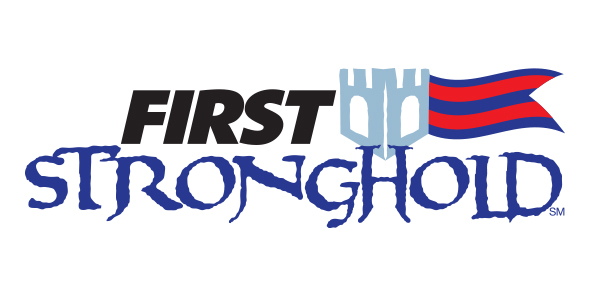
2016 Game: FIRST Stronghold
Lakota Robotics | Game Announcements
2016 Game: FIRST Stronghold
Robot Name: Robinhood
In honor of: Robin James

Field
The playing field is divided into red and blue alliance sections, separated by a neutral zone that contains boulders. Each section contains a courtyard, an area for opposing teams to shoot boulders at the castle goals, a “secret passage” that allows human players to feed boulders to their robots from the human player station, the “outer works”, and the tower.
Outer works
The outer works is the series of five defensive obstacles that divide the neutral zone from the alliance sections and span the field. Four of the five used obstacles are modular and can be moved, and certain obstacles may or may not be present during a match. Options for defensive obstacles include a cheval de frise, a “moat”, ramparts, a drawbridge, a sally port, a portcullis, a rock wall, and “rough terrain”. The defensive obstacle on the left of each outer works, the “low bar”, is not movable. LED light strips at the base of each obstacle display current obstacle strength.
Three defensive obstacles of the outer works in a particular match are determined by the teams playing the match and one obstacle is chosen by the audience.
There are over 18,000 possible field configurations from the eight defensive options.
After problems with robots and boulders getting stuck in the fabric on the low bar, FIRST made the decision to have it replaced with rubber flaps at some events (including the Championship).
Tower
The tower consists of five scoring goals, three scaling rungs, and a “batter”. Three high goals are 7 feet 1 inch above the playing field, and two low goals are six inches above the playing field. Three rungs for robots to scale the tower are 6 feet 4 inches from the playing field. Colored LED light strips on the front of the tower display the current tower strength. The “batter” is a series of seven 60° ramps at the base of the tower directly in front of the low goals designed to make challenging and scaling the tower difficult. The tower has a health of 8 for regional and district play and a health of 10 at the FIRST Championship.

Boulders
Scoring elements are called boulders, grey foam balls that are 10 inches in diameter. There are 12 boulders present on the field at the beginning of a match and 18 total. Six boulders are staged evenly along the mid line of the field, and three boulders are at each human player station and one in each robot.
Game play and scoring
Stronghold is a medieval tower defense game in which two alliances of up to three teams each compete to score points by breaching the opponent’s outer works and capturing the opponent’s tower. Before the match, teams and the audience select defenses to fortify the alliance’s outer works. Teams receive two ranking points in the competition standings for a win, and one ranking point for a tie.
Each match begins with a 15-second autonomous period where robots act on pre-programmed instructions. The match then transitions to a 2 minute and 15 second teleoperated (tele-op) period, where robots are driven by the drive teams.
Autonomous (auto) period
Robots begin in the neutral zone with the ability to hold one boulder each. However, alliances may assign a “spy” robot to start in the opposing alliance’s courtyard. Alliances earn 2 points for reaching the opposing alliance’s outer works, and earn 10 points for crossing them. Any additional defenses a robot crosses in auto will not decrease a defense’s strength, or give points to the alliance. Once across a defense, a robot in autonomous mode can score a high goal for 10 points or low goal for 5 points.
Tele-operated (tele-op) period
Robots retrieve boulders from either their secret passage or the mid line, overcome opponent defenses, and score goals in their opponent’s courtyard. Robots may transport only one boulder at a time. Each time a robot crosses an undamaged defense, they receive 5 points. Robots earn 5 points for scoring a high goal, and 2 points for a low goal. In the last 20 seconds of the match, robots race to the opposing alliance’s tower to either park on the batter, earning them 5 points for a challenge, or hang from the tower’s rungs, earning them 15 points for a scale.
Special scoring
A robot getting ready to shoot a boulder into the high goal
There are opportunities to score additional points by completing certain tasks in FIRST Stronghold. This can be done through breaching and or capturing, and will award the alliance either ranking points in the qualification matches or regular points in the playoff matches.
Breach
Any time a robot successfully crosses one of the opponent’s defenses (whether in autonomous or tele-op), that defense’s strength is reduced by 1/2. The second time a robot crosses the defense, that defense’s strength is reduced completely and is considered “damaged”. Once four of the five defenses are damaged, the outer works are considered breached. A breach is awarded 1 ranking point in qualifications and 20 points in playoffs.
Capture
As goals are scored in the opposing alliance’s tower, the tower’s strength will be lowered. After 8 goals (high or low), or 10 goals at the World Championships, the tower has no strength and is considered “weakened”. Only a weakened tower can be captured. To capture a tower, all robots in the alliance must either drive onto the opposing team’s batter, or scale the tower. Once the capture has been declared, the tower will turn to the capturing alliance’s color, and their flag will be raised. For capturing, the alliance receives 1 ranking point in qualifications, and 25 points in the playoffs.

2015 Game: Recycle Rush
Lakota Robotics | Game Announcements
2015 Game: Recycle Rush
Robot Name: Relicycle
In honor of: Ryan Reliford

Game Overview
RECYCLE RUSH is a recycling-themed game designed for the 2015 FIRST Robotics Competition (FRC). It is played by two Alliances of three Teams each. Alliances compete simultaneously to score points by stacking Totes on Scoring Platforms, capping those stacks with Recycling Containers, and properly disposing of Litter, represented by pool noodles, in designated locations. In keeping with the recycling theme of the game, all scoring elements used are reusable or recyclable by teams in their home locations or by FIRST at the end of the season.
Field
The 27 ft. by 54 ft. playing Field is bisected by a small Step which may not be climbed on or crossed by Robots. Thus each Alliance competes on their respective 26 ft. by 27 ft. side of the Field.
Match
Each RECYCLE RUSH Match begins with a 15-second Autonomous Period in which Robots operate independently of their drivers. During this period, Robots attempt to move themselves, their Yellow Totes, and their Recycling Containers into the area between the scoring platforms, called the Auto Zone. Additional points are awarded if the Yellow Totes are arranged in a single stack.
During the remaining 2 minutes and 15 seconds of the Match, called the Teleop Period, Robots are controlled remotely by student drivers located behind the walls at the ends of the Field. Teams on an Alliance work together to place as many Totes on their Scoring Platforms as possible. Alliances earn additional points for Recycling Containers placed on the scored Totes, with Recycling Containers at greater heights earning more points. Alliances also earn points for disposing of their Litter in either their Landfill Zone (the area next to the Step marked by the white line) or placing Litter in or on scored Recycling Containers. Alliances that leave unscored Litter marked in the other Alliance’s color on their side of the Field at the end of the match add points to the score of the other Alliance, as it is considered unprocessed and not properly disposed.
Alliances have an opportunity to earn “Coopertition Points” by coordinating with the other Alliance in the Match. Coopertition Points are awarded if, at some point in the Match, there are at least four Yellow Totes on the Step simultaneously. Coopertition Points are doubled if the Alliances arrange at least four of those Yellow Totes in a single stack on the Step. Points for the Match are awarded based on the state of the scored objects at the end of the Match (with the exception of Coopertition Points, which can be earned at any point during the Match).

2014 Game: Aerial Assist
Lakota Robotics | Game Announcements
2014 Game: Aerial Assist
Robot Name: Jiminy Flik’It
In honor of: Jimmy Nichols

Match Periods
In Aerial Assist, each match is 2 minutes and 30 seconds long, and consists of 2 periods.
- Autonomous – first 10 seconds. Code on the robots is remotely activated, and robots may react to sensor inputs and commands programmed into the robot’s onboard control system. The robot tries to score a ball into a high or low goal and move forward into it’s colored alliance zone.
- Teleoperated – 2 min, 20 sec, starting after the Autonomous Period. Humans remotely control their robots to try to earn points by scoring the ball in a goal (high or low), shoot it and catching it over the truss, and passing the ball to their alliance teamates down the field. To score passing points a robot must pass the ball to another robot in a different colored zone or take the ball into a different colored zone to their partner and pass it to them there (In other words, robots cannot pass the ball in only one colored part of the field; it has to move to different parts).

Field
The FIELD for AERIAL ASSIST is a 24 ft. 8 in. x 54 ft. carpeted area, bounded by and including the GUARDRAILS, ALLIANCE WALLS, and rear faces of the LOW GOALS. The FIELD floor is covered with carpet. Two HIGH GOALS are located at each end of the FIELD above the ALLIANCE WALLS. Two LOW GOALS are located in the corners next to each ALLIANCE WALL. A TRUSS bisects and spans the width of the FIELD. There is retro-reflective tape areas on both of the high goals. In Auton, teams can use cameras on their robots to detect when one of these is lit up (called: “hot”). It will stay lit/”hot” for 5 seconds (which one is lit being determined randomly).
Scoring
The following is how points are scored during the autonomous period.
| Ball in low goal | 6 Points | 11 Points if “hot” |
| Ball in high goal | 4 Points | 20 Points if “hot” |
| Robot moves to alliance zone | 6 Points |
The following is how points are scored during teleoperated mode.
| Ball in low goal | 1 Point with 1 assist | 11 Points with 2 assists | 31 Points with 3 assists |
| Ball in high goal | 10 Points with 1 assist | 20 Points with 2 assists | 40 Points with 3 assists |
| Ball over the truss | 10 Points | ||
| Catch ball from over the truss | 10 Points |
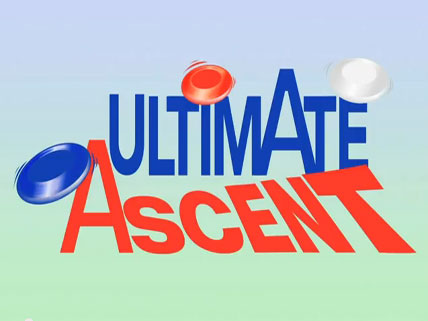
2013 Game: Ultimate Ascent
Lakota Robotics | Game Announcements
2013 Game: Ultimate Ascent
Robot Name: Flying Saunders
In honor of: Susan Saunders (“Mama Saunders”)
Field
Ultimate Ascent is played on a 27′ x 54′ field. There are two pyramids placed in the center of each half of the field. There are five scoring locations located on the opposite end of the field from the alliance station where that teams drivers are. Four of the goals are located on the opposing alliance’s wall. The fifth is part of the pyramid at that end of the field.
Matches
Scoring
Teams start with up to 2 or 3 discs on the robot at the beginning of the match. Robots which begin touching the carpet behind their colored Auto Line may have three discs; others may have only two. They can score these in autonomous or wait for the teleoperated period. Only the 6 discs of an alliance’s color count when scored on top of its pyramid. White or opposing colored discs will not count if scored in the pyramid. Since the human players may not put any colored discs in play until teleoperated, scoring in the pyramid is not possible in autonomous. Teams can score points as follows by scoring discs into goals:
| Goal | Autonomous | Teleop |
| Low Goal | 2 | 1 |
| Middle Goal | 4 | 2 |
| High Goal | 6 | 3 |
| Pyramid Goal | N/A | 5 |
| Level | Points |
| 1 | 10 |
| 2 | 20 |
| 3 | 30 |
